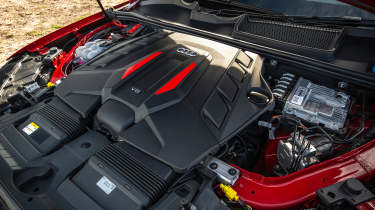Audi SQ7 – engine, gearbox and technical highlights
The 4-litre twin-turbo V8 is shared with other Volkswagen Group products, and there’s an array of clever chassis systems to harness it
The second-gen Q7 launched in 2015, but that doesn’t mean the SQ7 is lumbered with old tech. Under the bonnet you’ll find the Volkswagen Group’s 4-litre twin turbo V8, shared with the likes of the Porsche Cayenne S and producing 500bhp in this tune. It uses a 48-volt mild-hybrid system to benefit efficiency, plus cylinder deactivation.
The motor is paired with an eight-speed torque converter automatic, sending power to all-four wheels via a permanent quattro four-wheel drive system with a locking centre diff. The top-spec Vorsprung also gets a torque vectoring rear diff as standard, shifting drive between the wheels to aid rotation under power.
There are more chassis systems to manage what is a tall, three-row behemoth, such as active roll stabilisation. This splits the roll bars in two with an electric motor in the middle, which can apply a force to counteract roll, or effectively decouple the two halves to benefit ride quality. This works together with standard-fit air suspension and adaptive dampers with three stiffness settings, and a progressive-rate steering rack.
All SQ7s roll on enormous 22-inch wheels as standard, with 285-width tyres at both axles. Nestled behind the wheels is a mammoth braking package, comprising 400mm front discs and 350mm rears – helpful when you have 2265kg to stop…
Odd though it is, the SQ7 actually counts as a lightweight in the context of its chief rival, the BMW X7 M60i. The BMW is longer, wider and taller and has an extra 410kg to lug around. No, that isn’t a typo.




